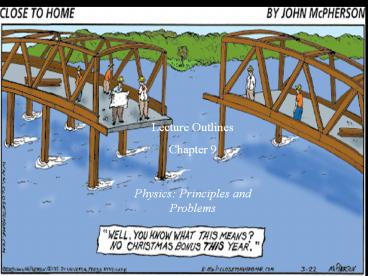Lecture Outlines PowerPoint PPT Presentation
Title: Lecture Outlines
1
Lecture Outlines Chapter 9 Physics Principles
and Problems
2
Chapter 9Linear Momentum and Collisions
3
Units of Chapter 9
Linear Momentum Impulse Conservation of Linear
Momentum Elastic and Inelastic Collisions Center
of Mass Jet Propulsion and Rockets
4
6.1 Linear Momentum
Definition of linear momentum The linear
momentum of an object is the product of its mass
and velocity.
Note that momentum is a vectorit has both a
magnitude and a direction. SI unit of momentum
kg m/s. This unit has no special name.
5
6.1 Linear Momentum
For a system of objects, the total momentum is
the vector sum of each.
6
6.1 Linear Momentum
The change in momentum is the difference between
the momentum vectors.
7
6.1 Linear Momentum
If an objects momentum changes, a force must
have acted on it.
The net force is equal to the rate of change of
the momentum.
8
6.2 Impulse
Impulse is the change in momentum
Typically, the force varies during the collision.
9
6.2 Impulse
Actual contact times may be very short.
10
6.2 Impulse
When a moving object stops, its impulse depends
only on its change in momentum. This can be
accomplished by a large force acting for a short
time, or a smaller force acting for a longer time.
11
6.2 Impulse
We understand this instinctivelywe bend our
knees when landing a jump a soft catch (moving
hands) is less painful than a hard one (fixed
hands). This is how airbags workthey slow down
collisions considerablyand why cars are built
with crumple zones.
12
6.3 Conservation of Linear Momentum
If there is no net force acting on a system, its
total momentum cannot change. This is the law of
conservation of momentum. If there are internal
forces, the momenta of individual parts of the
system can change, but the overall momentum stays
the same.
13
6.3 Conservation of Linear Momentum
In this example, there is no external force, but
the individual components of the system do change
their momenta
14
6.3 Conservation of Linear Momentum
Collisions happen quickly enough that any
external forces can be ignored during the
collision. Therefore, momentum is conserved
during a collision.
15
6.4 Elastic and Inelastic Collisions
In an elastic collision, the total kinetic energy
is conserved. Total kinetic energy is not
conserved in an inelastic collision.
16
6.4 Elastic and Inelastic Collisions
A completely inelastic collision is one where the
objects stick together afterwards.
17
6.4 Elastic and Inelastic Collisions
The fraction of the total kinetic energy that is
left after a completely inelastic collision can
be shown to be
18
6.4 Elastic and Inelastic Collisions
For an elastic collision, both the kinetic energy
and the momentum are conserved
19
6.4 Elastic and Inelastic Collisions
Collisions may take place with the two objects
approaching each other, or with one overtaking
the other.
20
6.5 Center of Mass
Definition of the center of mass The center of
mass is the point at which all of the mass of an
object or system may be considered to be
concentrated, for the purposes of linear or
translational motion only. We can then use
Newtons second law for the motion of the center
of mass
21
6.5 Center of Mass
The momentum of the center of mass does not
change if there are no external forces on the
system. The location of the center of mass can be
found
This calculation is straightforward for a system
of point particles, but for an extended object
calculus is necessary.
22
6.5 Center of Mass
The center of mass of a flat object can be found
by suspension.
23
6.5 Center of Mass
The center of mass may be located outside a solid
object.
24
6.6 Jet Propulsion and Rockets
If you blow up a balloon and then let it go, it
zigzags away from you as the air shoots out. This
is an example of jet propulsion. The escaping air
exerts a force on the balloon that pushes the
balloon in the opposite direction. Jet propulsion
is another example of conservation of momentum.
25
6.6 Jet Propulsion and Rockets
This same phenomenon explains the recoil of a gun
26
6.6 Jet Propulsion and Rockets
The thrust of a rocket works the same way.
27
6.6 Jet Propulsion and Rockets
Jet propulsion can be used to slow a rocket down
as well as to speed it up this involves the use
of thrust reversers. This is done by commercial
jetliners.
28
Summary of Chapter 6
Momentum of a point particle is defined as its
mass multiplied by its velocity. The momentum of
a system of particles is the vector sum of the
momenta of its components. Newtons second law
29
Summary of Chapter 6
Impulsemomentum theorem
In the absence of external forces, momentum is
conserved. Momentum is conserved during a
collision. Kinetic energy is also conserved in an
elastic collision.
30
Summary of Chapter 6
The center of mass of an object is the point
where all the mass may be considered to be
concentrated. Coordinates of the center of mass

